Baseball diamonds are like snowflakes: no two are alike. It’s one of the things that makes the sport great.
Ask any baseball fan what they love most about the sport and they’ll likely give you a similar answer, something that makes baseball unique among all other games. There’s no clock. It’s played nearly daily for seven months (well, usually). The players’ boss wears pajamas.
What sticks out to me is how no two fields are alike. Every football field is 300 feet long and 160 feet wide. Basketball courts, from high school to college to the NBA, are 94 feet by 50 feet. But baseball teams get to choose how their playing surface will be shaped, and that decision has wide-ranging implications.
A bandbox park will benefit groundball pitchers, while a cavernous outfield like the Rockies’ will cut down on home runs at the expense of more doubles and triples. Fences can be shallower on one side or another to give an advantage to batters who hit from that side of the plate. The walls can meet at odd angles, requiring an outfielder to be familiar with how a ball might carom, lest he allow two bases to be turned into three. Even the height of the fences varies, keeping scorched liners from leaving the park or preventing outfielders from bringing back wall-scrapers.
Taken together, these things have a profound impact on the game we love. How many times have you watched an opposing player homer against your team and said, “That would’ve been an out if we were playing at home!”?
In baseball’s slightly less professional days, it was played in stadiums that may as well have been designed by M.C. Escher. The Polo Grounds in New York was 257 feet down the line in right but 483 feet to center. The ground in leftfield at Cincinnati’s Crosley Field sloped upwards at 15 degrees. The centerfield boundary at the original Yankee Stadium was nearly 500 feet from home, with a flagpole and three memorial monuments in play. Such idiosyncrasies would rightly be considered amateurish in today’s game, but modern stadiums still possess plenty of characteristics that make them unique. And so I’ve decided to rank each outfield in MLB, based on my totally subjective tastes.
(A big thank you is owed to thirty81project.com for its collection of stadium schematics and to Clem’s Baseball for its exhaustive archive of historical stadium dimensions.)
30. Kauffman Stadium (Royals)
Measurements, in feet (L-R, dead center in bold): 330, 387, 410, 387, 330
The K, constructed in the late ’60s and early ’70s, was built during the boom of “cookie-cutter” multipurpose stadiums. And while neighboring Arrowhead Stadium hosted Kansas City’s football team, Kauffman retained the same symmetrical dimensions associated with the era’s baseball-football combo stadiums.
29. Rogers Centre (Blue Jays)
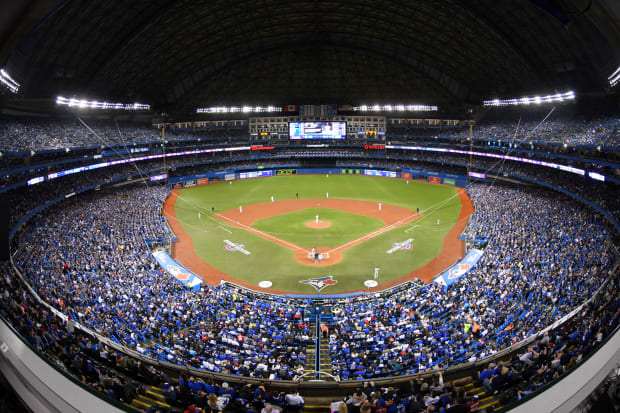
Measurements, in feet (L-R, dead center in bold): 328, 375, 400, 375, 328
Kansas City and Toronto are the only two stadiums in MLB with symmetrical outfield dimensions and uniform wall height.
BONUS: TD Ballpark
Measurements, in feet (L-R, dead center in bold): 333, 380, 400, 363, 336
The Jays will open the 2021 season playing at their spring training facility in Dunedin, Fla., TD Ballpark. The stadium underwent a significant renovation before the 2020 season, which included lowering the height of the leftfield fence. The current layout is a bit like a mirror image of Target Field in Minneapolis. It features a deep power alley in left-center and a tall fence in right. Much more interesting than the Jays’ usual digs.
28. Busch Stadium (Cardinals)
Measurements, in feet (L-R, dead center in bold): 336, 375, 400, 375, 335
When the multipurpose Busch Stadium II was replaced by the current ballpark, the Cardinals only changed the dimensions minimally. Though the walls are straight rather than curved, the stadium plays much like it did when Mark McGwire was chasing Roger Maris’s record.
27. Dodger Stadium
Measurements, in feet (L-R, dead center in bold): 330, 360, 375, 400, 375, 360, 330
Built in 1962, Dodger Stadium looks a lot like Kauffman, but the Chavez Ravine park gets a few bonus points for its low walls (four feet) in the corners that allow for some spectacular home run robberies.
26. Guaranteed Rate Field (White Sox)
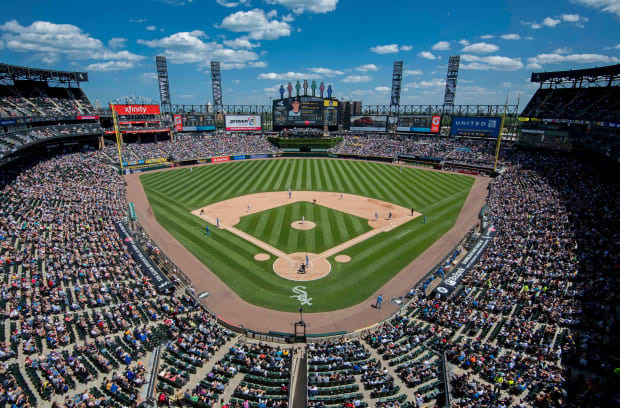
Measurements, in feet (L-R, dead center in bold): 330, 375, 400, 375, 335
The dimensions of “New Comiskey” when it opened in 1991 were quite similar to those of its predecessor, with the foul poles 347 feet from home plate. A renovation beginning in 2001 brought the fences in at the corners to 330 feet in left and 335 in right, similar to Old Comiskey’s 1970s layout (335 feet to both corners). As a result, the park began playing more to the batters’ advantage after initially being a pitcher’s park.
25. Oakland Coliseum (Athletics)
Measurements, in feet (L-R, dead center in bold): 330, 388, 400, 388, 330
The Coliseum is the most charmless stadium in all of baseball. It’s a crumbling former football stadium built in 1966 that’s rarely more than half full. That outfield, though, does have some charm. One of the peculiarities of the multipurpose stadium is the retractable seating that causes the walls in left- and right-center to rise to 15 feet. And because of the stadium’s unorthodox football layout (from third base to first base, rather than from third to rightfield), the left- and right-centerfield power alleys are 388 feet from the plate, making Oakland one of the best parks for hitting triples, at the expense of homers. And who doesn’t love triples?
24. Marlins Park
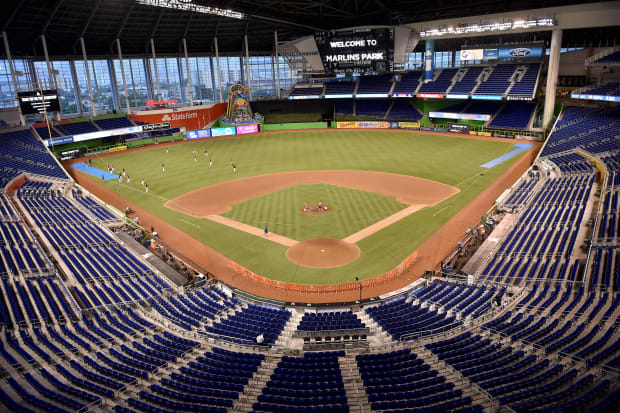
Measurements, in feet (L-R, dead center in bold): 344, 386, 400, 387, 335
Removing the wacky home run sculpture in centerfield diminished the charm of Marlins Park in more ways than one. The psychedelic, animatronic work of art was taken down before the 2019 season but the outfield fence still curved around its former home. For the 2020 season, the centerfield wall was brought in to erase any memory of what once stood there.
23. Miller Park (Brewers)
Measurements, in feet (L-R, dead center in bold): 344, 371, 400, 374, 345
The distances are nearly symmetrical but the fences meet at some unexpected angles, which at least adds some uncertainty to balls hit off the wall.
22. T-Mobile Park (Mariners)
Measurements, in feet (L-R, dead center in bold): 331, 378, 401, 381, 326
Seattle’s ballpark used to be one of the most pitcher-friendly in baseball. Specifically, a cavernous left-centerfield power alley allowed more doubles (and way more triples) to righthanded batters than to lefties. But the Mariners moved in the fences in that part of the park by up to 17 feet before the 2013 season, which has produced more homers, even though T-Mobile remains a pitcher’s park. Left-center is still roomier than right-center, though, and so righties still pick up significantly more triples.
21. Citi Field (Mets)
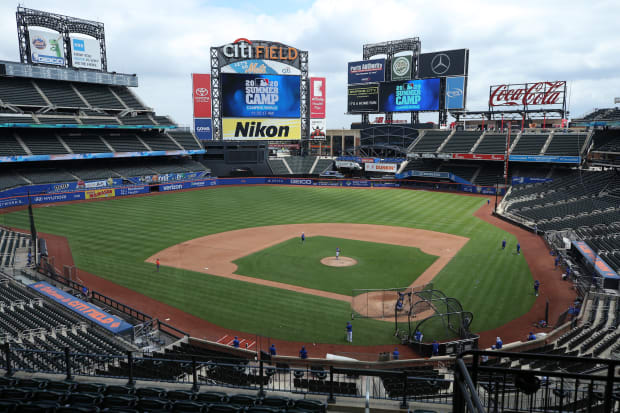
Measurements, in feet (L-R, dead center in bold): 335, 358, 385, 408, 398, 375, 330
Citi Field is a monument to doing too much with a modern outfield wall. When it opened in 2009, it was one of MLB’s most spacious parks. It also boasted some very tall fences. Out in left, “The Great Wall of Flushing” stood 15 feet tall and 384 feet away. Only three years later, after the stadium proved too difficult to hit home runs in, the fences were moved in and made eight feet tall. Three years later, another renovation brought the fence in right-center in by 10 feet. The result is a fairly standard ballfield.
20. Tropicana Field (Rays)
Measurements, in feet (L-R, dead center in bold): 315, 370, 404, 370, 322
Say what you will about the Trop, the outfield isn’t that bad. The corners are shallow and the walls in left and right are straight, rather than curved, keeping the power alleys from reaching too far back. Where the park loses points, though, is with its catwalks. They’re not technically part of the outfield wall but no stadium should have obstacles above the field of play that can interrupt the flight of a batted ball.
19. Truist Park (Braves)
Measurements, in feet (L-R, dead center in bold): 335, 385, 400, 375, 325
Leftfield is slightly deeper than right but the wall in left is 16 feet high. The result is visually appealing and doesn’t really favor hitting from either side of the plate.
18. Wrigley Field (Cubs)
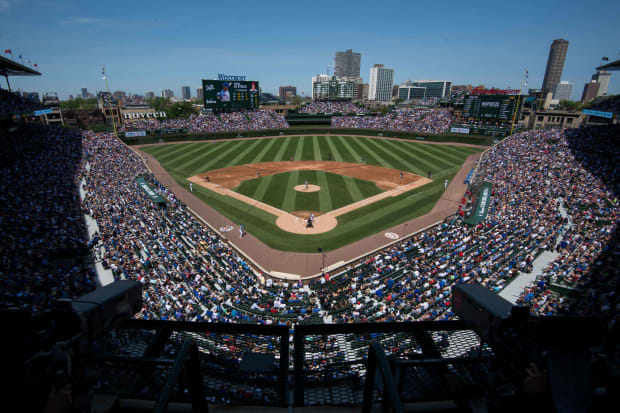
Measurements, in feet (L-R, dead center in bold): 355, 368, 400, 368, 353
In its early days, the Wrigley outfield was a janky mess. The former Weeghman Park changed its dimensions frequently as new stands were built until settling on its current layout in 1938. While many stadiums of that era are known for short distances to the corners (Crosley Field and Forbes Field are among the exceptions), Wrigley’s foul poles are 355 feet from the plate. Today, that’s the longest distance down the line of any field in baseball, farther even than Coors Field. But nobody pays attention to the measurements, anyway. They’re all distracted by the ivy.
17. Coors Field (Rockies)
Measurements, in feet (L-R, dead center in bold): 347, 390, 415, 375, 350
Look, there’s basically no way to get a stadium in Denver to play like a normal baseball field. The walls are extra deep there to account for the way the ball carries at altitude, which cuts down on home runs but leads to an insane number of triples. It would be frustrating if MLB had a bunch of parks like Coors, but one is enough to be a refreshing oddity.
16. Angel Stadium
Measurements, in feet (L-R, dead center in bold): 347, 390, 396, 370, 365, 350
Angel Stadium’s dimensions are the result of optimizing the stadium for football when the Rams came to town and then reverting it to baseball-only status when they moved to St. Louis. It’s deep down the lines, but shallow in the middle, making Anaheim an average place to hit homers but very tough to leg out triples.
15. Comerica Park (Tigers)
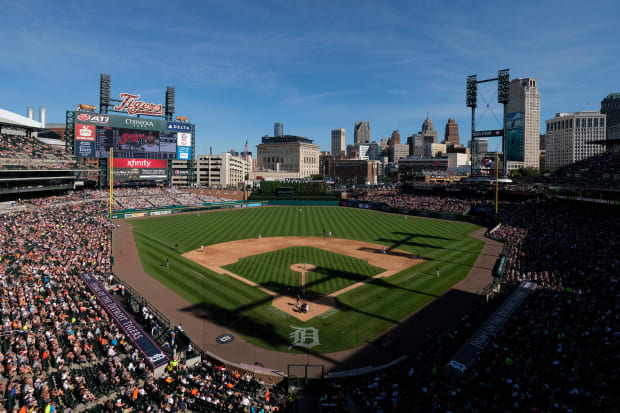
Measurements, in feet (L-R, dead center in bold): 345, 370, 420, 365, 330
Comerica was built to replace the ancient Tiger Stadium (1912–99) and was originally constructed with a turn-of-the-century oddity: a flagpole in play just left of dead-center, just like at the old park. But the original configuration had a left-center power alley of an absurd 395 feet, so the fences were brought in prior to the 2003 season and the flagpole was taken out of play. As a result, the field is small enough in the corners that guys can hit a decent number of home runs, but deep enough in the middle for talented centerfielders to be able to show off their range.
14. Great American Ball Park (Reds)
Measurements, in feet (L-R, dead center in bold): 328, 379, 404, 370, 325
GABP is one of the most notorious hitters’ parks in all of baseball, routinely among the top five in terms of home runs allowed. The outfield is not much bigger than Yankee Stadium but Cincinnati has one thing the Bronx does not: an extra high wall in left.
13. Nationals Park
Measurements, in feet (L-R, dead center in bold): 337, 377, 402, 370, 335
Nats Park doesn’t look that interesting at first glance. The distances down the lines, to the power alleys and to the deepest part of the park are standard. But the little indentation where the leftfield bullpen is and the tall scoreboard in right-center are nice touches.
12. Progressive Field (Indians)
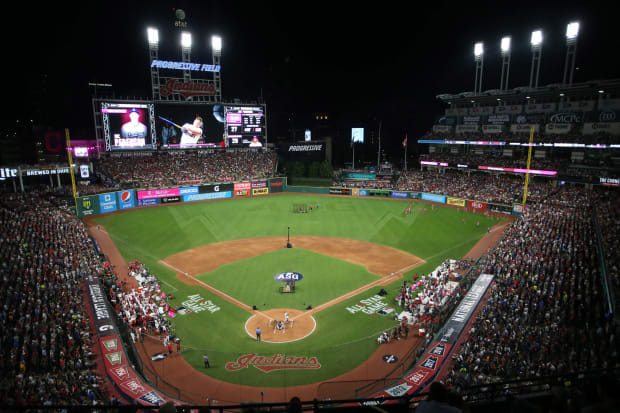
Measurements, in feet (L-R, dead center in bold): 325, 370, 400, 410, 375, 325
Pity the righthanded power hitter who has to play in Cleveland. On the whole, Progressive Field slightly favors hitters over pitchers, but the 19-foot wall in leftfield spells doom for many a ball that would be gone in many other stadiums.
11. Target Field (Twins)
Measurements, in feet (L-R, dead center in bold): 339, 377, 411, 403, 367, 328
That 23-foot wall in right is the fifth-tallest in MLB and serves as a great example of how much the aerodynamics of the baseball can impact the sport. Before balls mysteriously began flying farther, lefties had a very hard time lifting homers over that high boundary. In 2019, no team hit more homers than the Twins. Lefties Eddie Rosario and Max Kepler hit 32 and 36, respectively.
10. Oriole Park at Camden Yards
Measurements, in feet (L-R, dead center in bold): 333, 364, 410, 400, 373, 318
Camden Yards was a trailblazer in the movement toward retro-style parks. One of the old-school features is a big out-of-town scoreboard built into the rightfield wall. It climbs 21 feet into the air, which makes any ball hit over it and toward the warehouses across the street seem that much more impressive.
9. Chase Field (Diamondbacks)
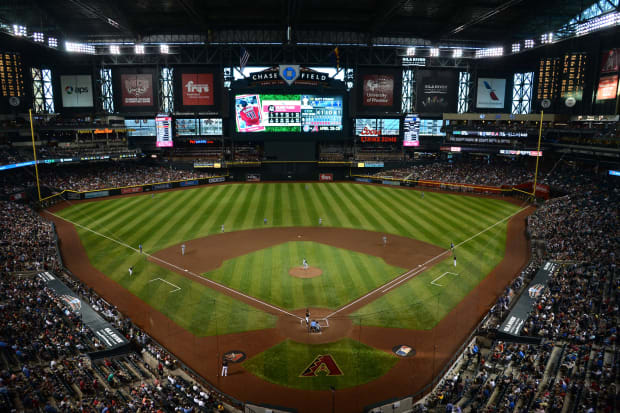
Measurements, in feet (L-R, dead center in bold): 330, 374, 413, 407, 413, 374, 334
Oh, your team’s park has a high fence near one of the foul poles? That’s cute. At Chase Field, the wall in center stands 25 feet tall. That, combined with centerfield’s generous dimensions, makes Arizona one of the most triple-prone parks in MLB. And triples are fun!
8. Globe Life Field (Rangers)
Measurements, in feet (L-R, dead center in bold): 329, 372, 407, 374, 326
At first glance, there’s nothing noteworthy about the outfield at the new Rangers ballpark. But the team has embedded all sorts of Easter eggs in the dimensions. The 329-foot distance down the line in left is a tribute to Adrian Beltre’s No. 29, likewise for the 407 mark in dead center (Ivan Rodriguez) and 326 in right (late manager Johnny Oates). No other team in baseball has done anything like this, and that’s pretty cool.
7. Petco Park (Padres)
Measurements, in feet (L-R, dead center in bold): 334, 357, 390, 396, 391, 382, 322
Petco Park has something no other stadium in baseball has. Instead of a yellow-painted aluminum pole in leftfield dividing fair from foul, there’s a 100-plus-year-old building. The park was constructed around the 1909-built Western Metal Supply Company building. Any ball that hits to the right of the building’s corner is a homer.
6. Citizens Bank Park (Phillies)
Measurements, in feet (L-R, dead center in bold): 329, 374, 409, 401, 369, 330
Philly has an outfield feature unlike any other park in baseball: a centerfield wall that’s dramatically shorter than the rest of the fences. That allows balls to escape the yard that wouldn’t have if they were hit a few feet to either side. It also means it’s not too hard for outfielders to leap and bring back would-be home runs.
5. Yankee Stadium
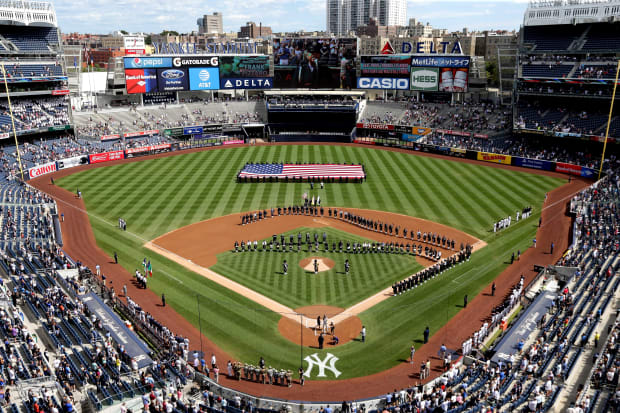
Measurements, in feet (L-R, dead center in bold): 318, 399, 408, 385, 314
If it ain’t broke, don’t fix it. The current iteration of Yankee Stadium has the exact same dimensions as its predecessor, though it doesn’t play exactly the same as the park that once sat across the street. Yankee Stadium is a reminder that park factors are about more than just dimensions and elevation. Despite identical outfield fences, it’s significantly easier to hit a home run (particularly over the famed short porch in right) at The House That Jeter Built than The House That Ruth Built. When the new stadium opened in 2009, the team commissioned a wind study to figure out why the ball was flying farther but the results don’t appear to have been publicized. Wind or not, the short porch is still an iconic stadium feature.
4. PNC Park (Pirates)
Measurements, in feet (L-R, dead center in bold): 325, 383, 410, 399, 375, 320
PNC has this nifty little feature that I hadn’t noticed until I started working on this project. The leftfield wall there is pushed back, forming a deep corner in left-center. That pocket is the deepest part of the park at 410 feet, 11 feet farther than dead center. The other thing that makes Pittsburgh’s stadium nice is the rightfield wall, which stands 21 feet tall in honor of Roberto Clemente. It’s a subtle nod to a franchise legend that can easily go unnoticed.
3. Minute Maid Park (Astros)
Measurements, in feet (L-R, dead center in bold): 315, 362, 404, 409, 408, 373, 326
Minute Maid’s outfield used to be a farce. The “Crawford Boxes” short porch in left is a great feature—an old-school peculiarity that has a palpable but not extreme impact on the game (righthanded batters have hit homers at a roughly league-average rate in recent seasons). One wacky feature gives a ballpark charm, but more than that is just ridiculous. Thankfully, the Astros removed the slope known as Tal’s Hill, with its in-play flagpole and 436-foot-deep fence, before the 2017 season.
2. Oracle Park (Giants)
Measurements, in feet (L-R, dead center in bold): 339, 364, 399, 391, 415, 365, 309
Hitting a home run out to right at San Francisco’s Oracle Park is one of the hardest things to do in baseball. The rightfield corner is a mere 309 feet from home plate, but the wall there rises to 25 feet, tied for the second-tallest fence in MLB, and juts back at such a severe angle that the distance increases quickly. That deep right-center power alley also makes Oracle a great park for triples, the most exciting play in baseball.
1. Fenway Park (Red Sox)
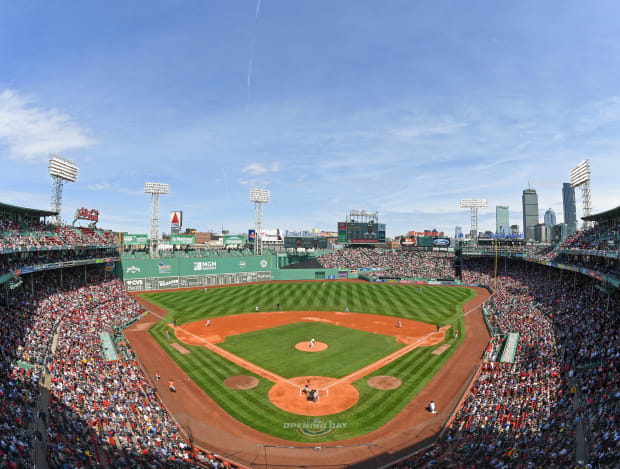
Measurements, in feet (L-R, dead center in bold): 310, 379, 390, 420, 380, 302
Of course Fenway belongs atop this list. The Green Monster is the most famous piece of architecture in sports. But the beauty of Fenway’s design is much deeper than just the leftfield wall made to compensate for a lack of real estate. Centerfield and left are equally idiosyncratic. In center, “The Triangle” creates a pocket of space where only the prodigious power hitter can launch a ball and only Jackie Bradley Jr. can track it down. Down the leftfield line, the “Pesky Pole” stands just 302 feet from the plate, turning looping flyballs into homers. But at the same time, the wall juts back dramatically as it extends away from the pole, quickly reaching 380 feet, making it the second-hardest park for lefthanded batters to homer in.
The other thing that makes Fenway beautiful is the variety of the heights of the various walls. The park has both the tallest and shortest outfield walls in MLB (from the 37-foot “Green Monster” in left, to the 3-foot barrier in right Torii Hunter famously flipped over while chasing a shot off the bat of David Ortiz in the 2013 ALCS).
It’s a Frankenstein of all sorts of quirks and oddities, but Fenway still plays like a fairly normal baseball field. Its park factors favor hitters, though not extremely. It’s basically as offense friendly as Progressive Field in Cleveland. That’s what makes baseball so special.